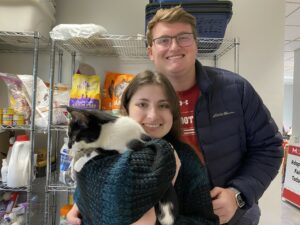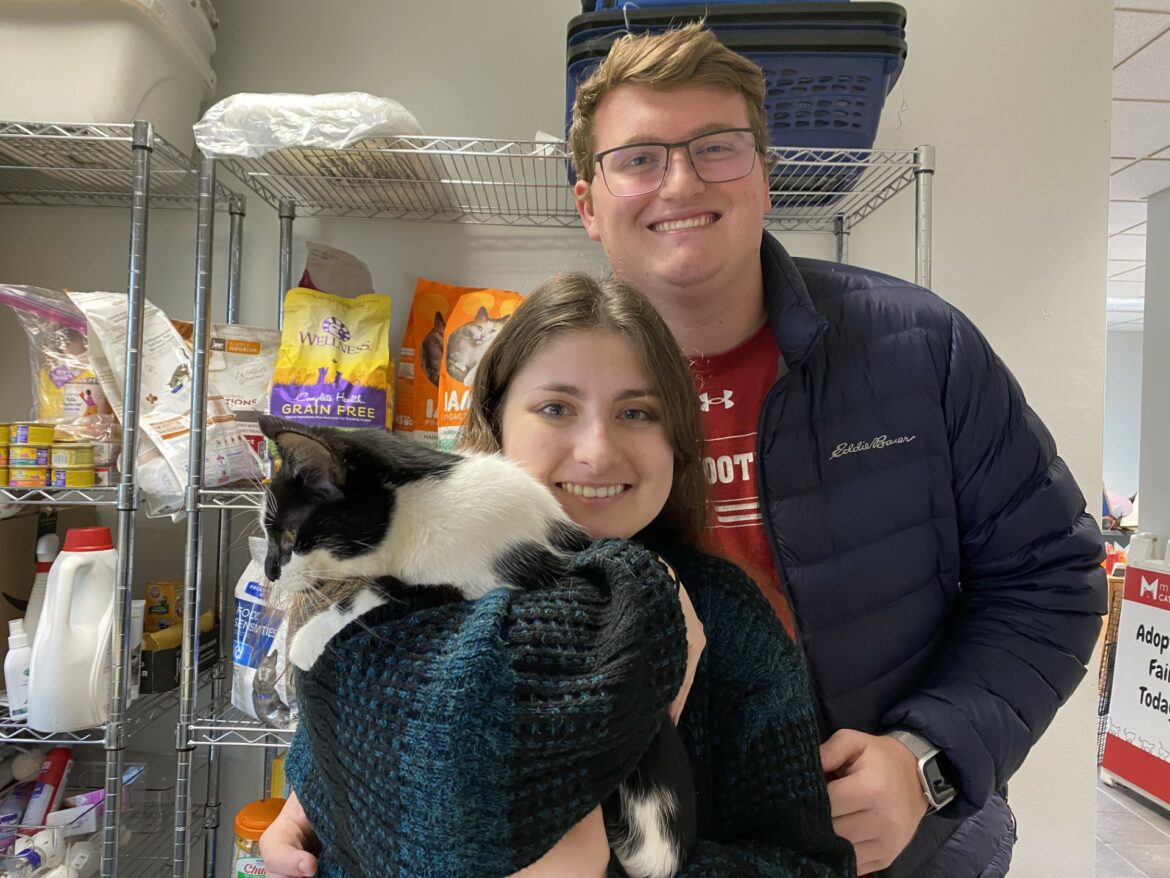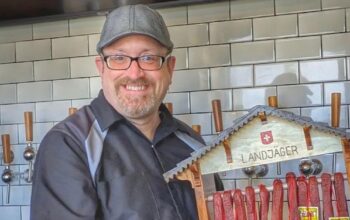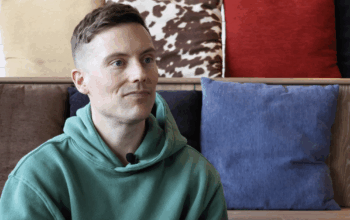Lindsey Haas walked into the Madison Cat Project’s monthly adoption fair on the afternoon of Oct. 21 and walked out with the second cat she adopted there since the summer of 2022.
Haas, a nursing student at Madison’s Edgewood College, wanted to adopt a second cat that would match the outgoing energy of her cat Dash, who she said becomes lonely when she and her partner are away from home.
“Since the adoption fair was going on, I just wanted to meet all of them and try to connect with one,” Haas said.
Haas visited a few of the five cages made comfortable with soft blankets and pillows, each containing three to five cats available for adoption. By the time she had arrived, all five of the fair’s kittens had been adopted out, leaving one cage empty.
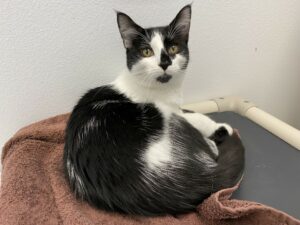
Some cats, like the large black-coated Captain Kangaroo, shied away from humans and hid in the small cardboard boxes laid out in the cages. But the six-month-old tuxedo kitten Bulat wooed her with playfulness and friendliness as he purred in her arms.
Bulat arrived at Madison Cat Project a mere two days earlier from another shelter. He left with Haas that afternoon.
“We thought a friend would be good [for Dash],” Haas said.
The Madison Cat Project, a small nonprofit based in Madison, hosts open-house adoption fairs every month at the organization’s shelter on Latham Drive where members of the public can visit and adopt cats without applying for adoption in advance. Of the 23 cats shown to the public on Oct. 21, 14 left with new families.
It’s not uncommon for the shelter to adopt out more than half the cats displayed at their adoption fairs, according to longtime volunteer Jennifer Lamb. Lamb, who has volunteered with the Madison Cat Project since 2011, said each adoption is vital because it creates space for the shelter to house another cat.
The Madison Cat Project, founded in 2001, comprises a small network of volunteers and approximately 70 fosters, who take shelter cats to live with them, often for months at a time. The Fitchburg shelter generally houses 30 to 35 cats at any given time and has attached surgical and exam rooms staffed by two certified veterinary technicians (CVTs) and a full-time medical director.
The Cat Project receives strays and cats returned by their owners, but most of their intake comes from other shelters, according to Meghan Randolph, the shelter’s development and communications coordinator. Shelters across the state coordinate with each other, allowing shelters to fly or drive cats to others when they are full.
“We actually take cats from everywhere,” Randolph said. “We do help a lot of southern shelters because they're just completely overrun. As overrun as we are up here, it is way worse in the South.”
Unlike other shelters, such as the Dane County Humane Society, the Cat Project’s status as a private organization allows them to decline to take in cats if their shelter is too full to adequately care for them, according to Lamb.
The Cat Project is an “adoption-guarantee” organization, Randolph said, which means that the shelter does not euthanize cats unless they have a terminal illness.
“Nobody wants to euthanize — it's just a reality in some shelters,” Randolph said. “A lot of the time, that's where we get the cats that are a little harder to place but may have some behavior issues or some health issues. Because we're a private shelter, we're able to take care of them and keep them until they get adopted.”
In 2022, the Cat Project reported an annual income of $680,000 and expenses of just over
$500,000. The shelter relies on individual donations, adoption fees, fundraising events and occasional infusions of grant money, according to Randolph. The money helps pay for the cats’ food, bedding and medical care.
The Cat Project’s team of volunteers run much of the shelter’s operations, including its busy monthly adoption fairs.
Lamb and other volunteers try to get a sense of each cat’s personality, including their friendliness with humans, dogs and other cats. Using that information, they look to match cats with the needs of potential adopters during the adoption fair.
“I walk in with these cats and read them — I won't call myself a cat whisperer, but you can get a pretty good feel for their personality in a few minutes,” Lamb said. “I've spent a lot of time learning their language, and you can get a feel for their personality pretty quick.”
If someone decides to adopt, they can leave with their new cat that afternoon. For a fee ranging from $45 to $150 based on the cat’s age, adopters can fill out an application card and bring their cat home with them if they have food, water and other necessities already in place at home.
The Cat Project practices the “Adopters Welcome” approach, in which shelters do not require adopters to submit financial or credit information in order to be eligible to adopt. This approach removes barriers to adoption, Lamb said, but still allows volunteers discretion to decline to adopt out a cat.
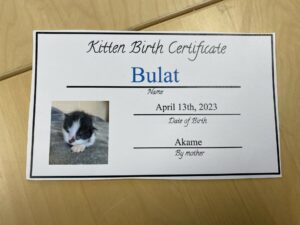
“It's mostly a judgment call,” Lamb said. “We feel that if somebody wants a cat, we'd rather have them get a cat from us who's spayed, neutered, microchipped [and] vaccinated than pick up a cat from a farm that has never been spayed . . . but if we do feel that there's a problem, we will say, ‘I'm sorry, I'm not going to be able to adopt this cat to you.’”
For Haas, the adoption process was straightforward. Lamb gave her information on Bulat’s age, medical history and dietary needs. She filled out and signed her adoption form, which included a pledge to care for Bulat to the best of her ability and to not declaw him.
After Haas signed the papers, she placed Bulat in a plastic carrier and took him to his new home.
“It was super easy,” Haas said. “They're great here.”
